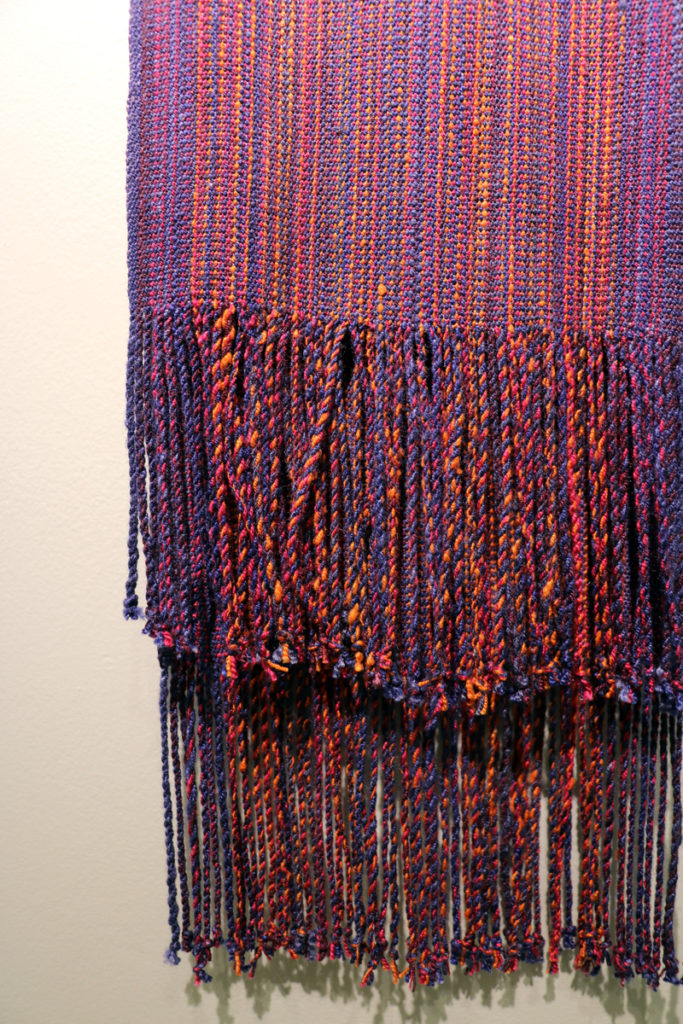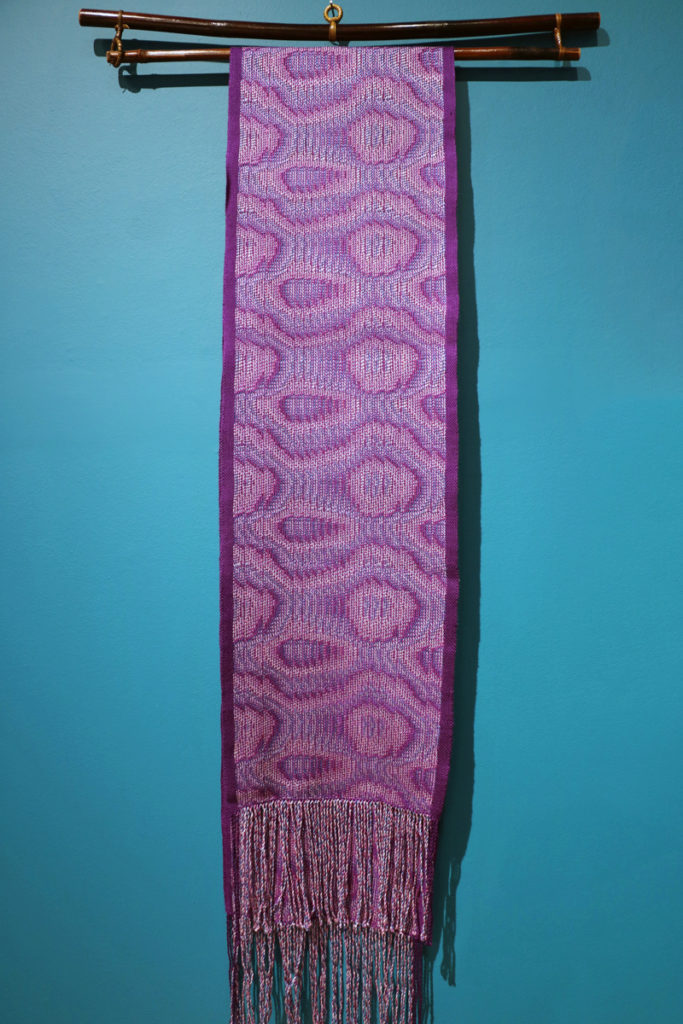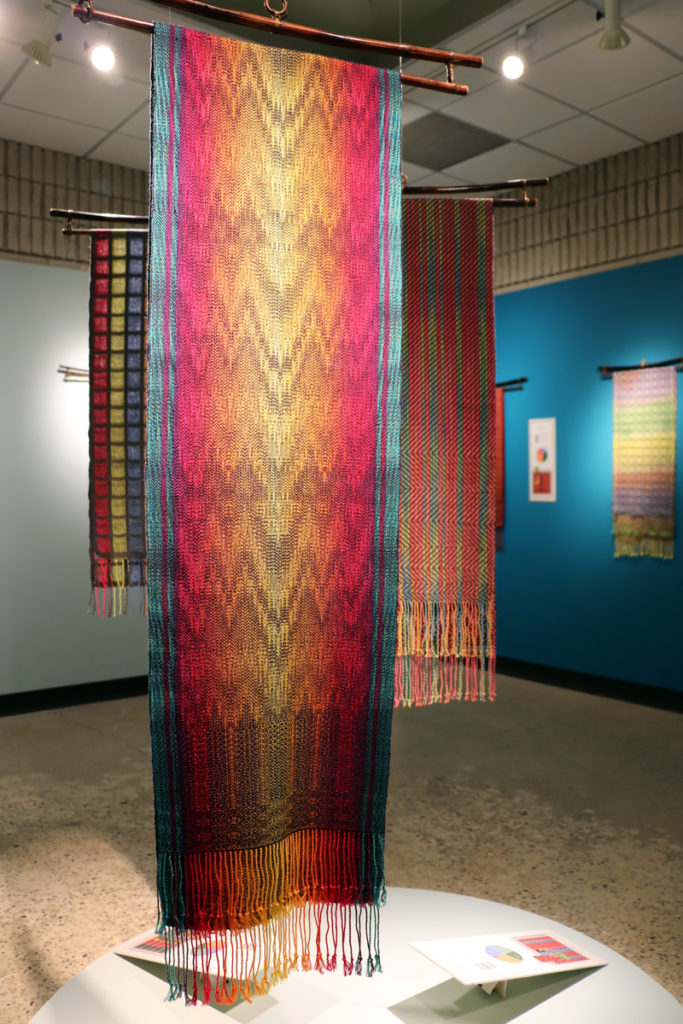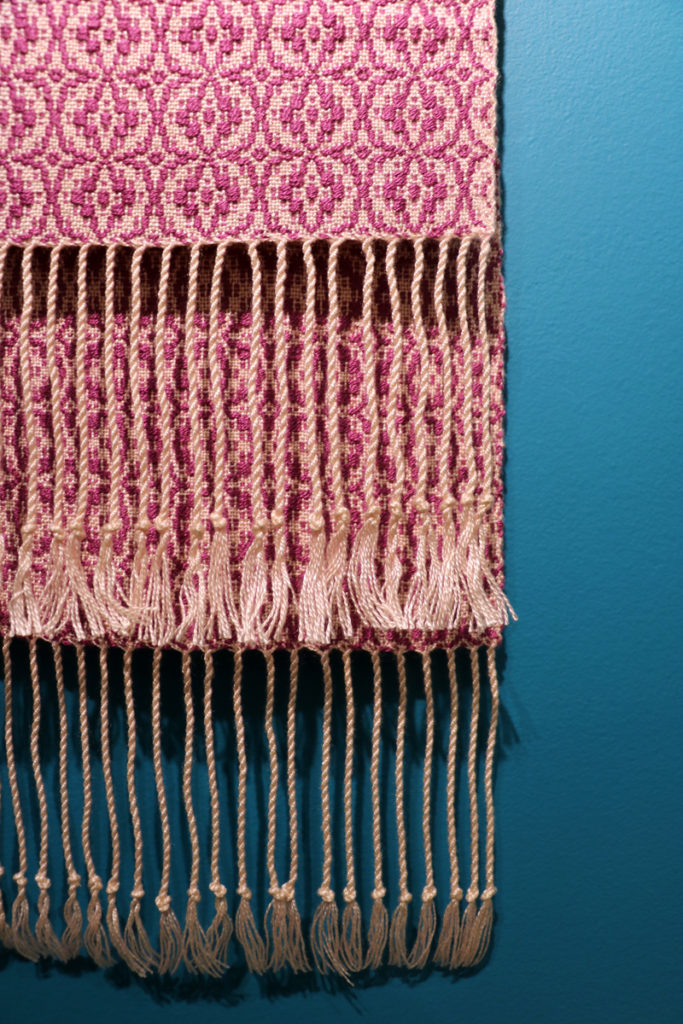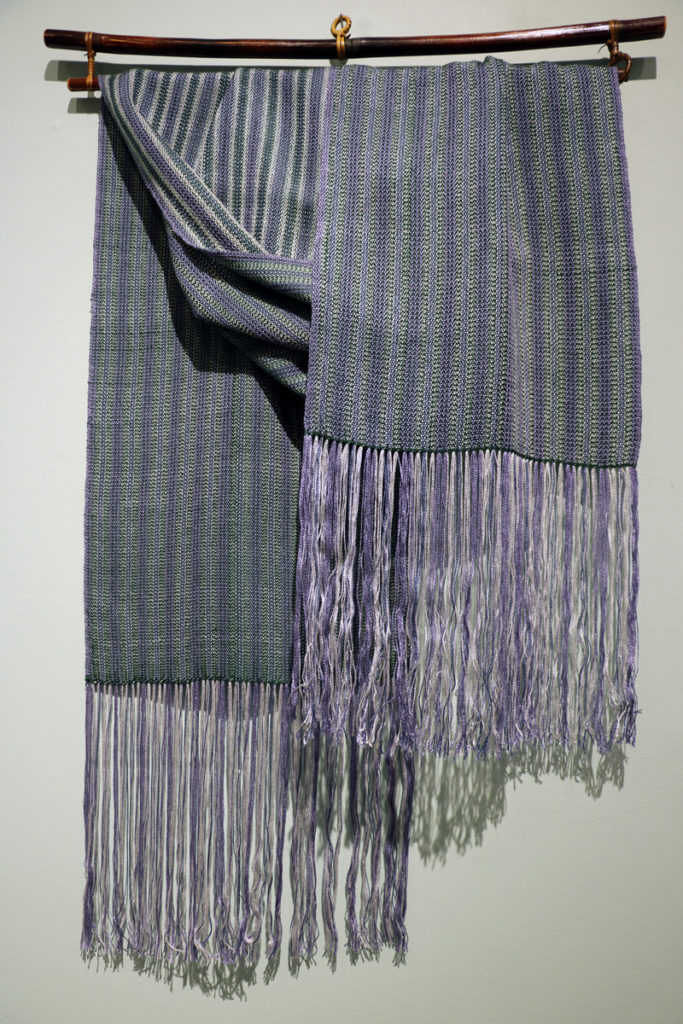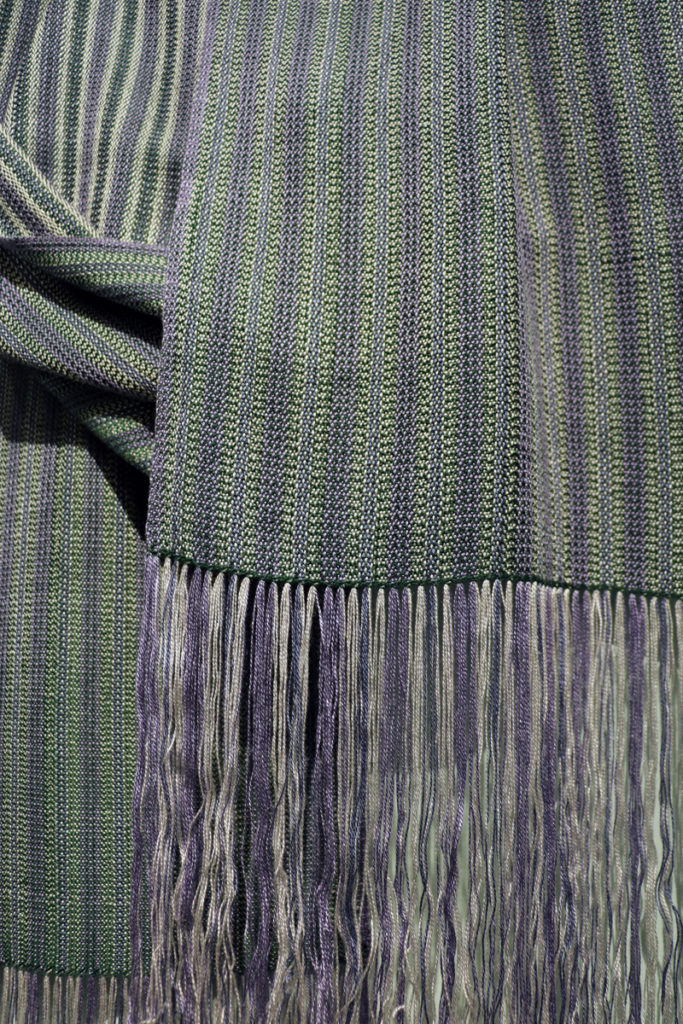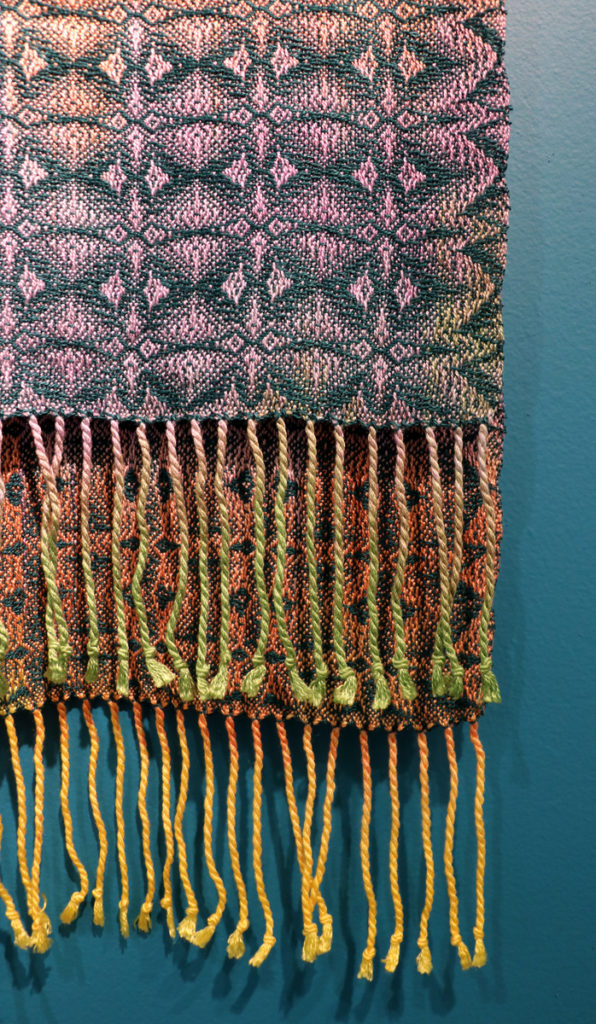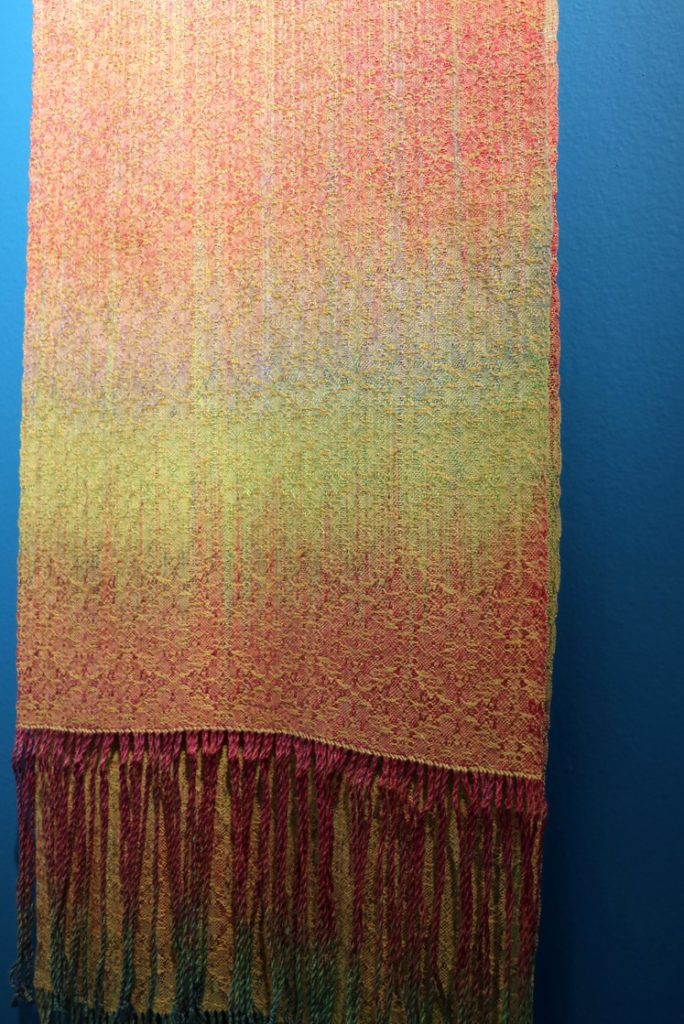Thank you to everyone that visited our Slow Cloth exhibit in person before the holiday season. The show ran September 7, 2021 to January 9, 2022. We hope you enjoy this virtual wander through our exhibition!
Slow Cloth is a textile exhibition that attempts to answer the age-old question, “How long does it take to make that?”
Sixteen artisans from the Burlington Handweavers & Spinners Guild took on the challenge to find out, and Slow Cloth is the result. From idea to end product, follow the creative journey of each weaver. By illustrating the process and telling the story of what goes into making handwoven scarves, we hope you’ll walk away with a new appreciation of this traditional handcraft—and never look at cloth the same way again.
From weavers with many years of experience to those just starting out, their task was to design and weave a scarf inspired by one of a set of five images, reflecting the colours, textures, and impressions in their woven pieces.

Each weaver kept careful track of the amount of time it took to make a scarf, recording each step along the way: planning and calculating the design, preparing the materials (handspinning, hand dyeing), preparing (“dressing or “warping”) the loom with thread, weaving, and finishing the textile (braiding or twisting the fringe, hemming, washing, pressing).
No two weavers ever tackle a project the same way. For Slow Cloth, each weaver allocated their time to the different steps according to their own preferences and skills, yielding a truly one-of-a-kind scarf.
After logging every stage and step, the answer to the popular question, “how long” was revealed. Of course, results vary due to each artist’s individual design choices, but on average, it takes an astonishing 41.5 hours to weave a single handwoven scarf.
Artists
Melanie Bailey Cox, Fran Boisvert, Elizabeth Bryan, Jennifer Earle, Marilyn Fish, Chris Hitchcock, Corinne Kossen, Victoria Lynch, Jennifer Neve, Gisela Risse, Karla Rivera, Veronica Scherrer-Pangka, Sue Stasiuk, Margaret Jane Wallace, Diane Woods, Lois Wyndham
Curator
Burlington Handweavers & Spinners Guild
Artist Statements & Project Notes
For comparison, according to ontariolivingwage.ca, the living wage in Halton Region is $20.38/hour.
Melanie Bailey Cox, Sunset on Water
Size: 7.25” x 62”
Thread: hand spun silk, Tencel
Weave structure: Plain Weave
Total time: 74.2 hours
Planning: 6.2
Preparing: 37.8
Warping: 7.4
Weaving: 14.5
Finishing: 8.4
Applying a living wage, the selling price for this item would be $1,512.
From the artisan… In making this piece, I was interested in the feelings and memories the source photo pulled to the front of my mind than the image itself. The photo calls back family holidays and is a reminder of the final rays of sunlight scattered and shimmering in the warm evening. I think of the colours of the water and the sky and can feel the evening’s first cool breeze across the water. The woven pattern draws these colours and the waves together and carries through the shimmer of the last light of the day.
Fran Boisvert, Reflections
Size: 10” x 83”
Thread: hand dyed silk
Weave structures: Echo Twill, 1/3 Broken Twill, Double Weave
Total time: 55.5 hours
Planning: 20
Preparing: 16.5
Warping: 7
Weaving: 9
Finishing: 3
Applying a living wage, the selling price for this item would be $1,131.
From the artisan… I choose to focus on one shell, the largest one in my inspiration picture. In designing the structure for the scarf, I wanted to depict the lines of color and texture of the shell as it would appear reflected under the water. The design of a twill line with another twill line echoed above that, and for a total of four twill lines gave me a reflection as if the shell was under the water surface. Silk was the fibre of choice for its reflective quality, drape, and warmth.
Elizabeth Bryan, Butterflies
Size: 7” x 74”
Thread: mercerized cotton
Weave structure: Twill
Total time: 16.5 hours
Planning: 2.4
Preparing: 0.6
Warping: 6.1
Weaving: 6.3
Finishing: 1.1
Applying a living wage, the selling price for this item would be $336.
From the artisan… I work with textiles because the yarn itself appears thin and delicate, but when woven together, has tremendous strength. Just as we are stronger than we think, so are cotton threads and butterflies. Both appear delicate but possess surprising strength. This scarf is an examination of the similarities between the butterfly and the single strands of cotton. I spent quite some time planning the design, based on a pattern by Marguerite Davison, to give the illusion of the butterfly body in the centre of the scarf. It appears that the butterfly’s journey is everlasting.
Jennifer Earle, Somewhere Over the Rainbow
Size: 13.5” x 96”
Thread: hand dyed Tencel
Weave structure: Modified Bateman Park Weave
Total time: 67.5 hours
Planning: 15.7
Preparing: 17.9
Warping: 15.3
Weaving: 13.9
Finishing: 4.8
Applying a living wage, the selling price for this item would be $1,376.
From the artisan… This piece represents a few challenges to me… firstly exploring and trying to understand a new weave structure and adapt it to multiple shafts and secondly the complex dyeing of the materials used. I’m pleased with the gradation achieved across the material. This was achieved by dyeing small warp chains and by intermixing these while threading.
Marilyn Fish, Sea Urchin
Size: 10.5” x 65.5”
Thread: Tencel
Weave structure: Overshot – Small Honeysuckle
Total time: 51.8 hours
Planning: 10.8
Preparing: 4.5
Warping: 9.3
Weaving: 10
Finishing: 8.4
Applying a living wage, the selling price for this item would be $1,056.
From the artisan… My photo reminded me of the sea urchins I have seen while snorkeling and their shells washed up on the beach. The round shapes required me to learn a new weaving technique called overshot. This project really brought home how much time is put into each woven piece.
Chris Hitchcock, Sea Stripes
Size: 12” x 84”
Thread: Tencel
Weave structure: Twill variation
Total time: 51.4 hours
Planning: 10.2
Preparing: 9.2
Warping: 16.5
Weaving: 7.1
Finishing: 8.4
Applying a living wage, the selling price for this item would be $1,048.
From the artisan… My main goal was to make a piece that reflected the stripe with central dots along each sea urchins shell. The draft was modified from one on handweaving.net, with the wrap threads chosen particularly to feature the line of dots.
Corinne Kossen, Dark Eyed Susan
Size: 15.5” x 70”
Thread: Tencel hand dyed
Weave structure: Snowflake Twill
Total time: 41.9 hours
Planning: 3.2
Preparing: 9.3
Warping: 10.4
Weaving: 17
Finishing: 2
Applying a living wage, the selling price for this item would be $854.
From the artisan… This scarf was an attempt to capture in colour and structure, something that exists so perfectly in nature that it can’t really be replicated. Although I like the product, it is the process of creating the scarf that pleased me most. I learned new skills, I formed new relationships, and I was inspired to do more.
Victoria Lynch, Funky Lizard
Size: 12.25” x 85”
Thread: hand dyed silk
Weave structure: Twill
Total time: 21.1 hours
Planning: 3.5
Preparing: 6.1
Warping: 5
Weaving: 2.3
Finishing: 4.2
Applying a living wage, the selling price for this item would be $430.
From the artisan… It is wonderful to be able to finally answer the question “How long does it take you?” I was surprised at how much time is spent planning a project. As with all hand-crafted projects, weaving is a labour of love.
Jennifer Neve, Water and Sunset
Size: 7.25” x 80”
Thread: Tencel
Weave structure: Deflected Doubleweave
Total time: 25.3 hours
Planning: 11.1
Preparing: 1.7
Warping: 3
Weaving: 4.3
Finishing: 5.2
Applying a living wage, the selling price for this item would be $516.
From the artisan… For me, weaving is about colour, and how those colours interact. Deflected double weave is a structure that is new to me. For this reason, I spent a long time planning so that I could understand how the individual threads would cross each other and complement, and not become too busy. I think the conclusion to the question of how long it takes to weave a scarf is: as long as I enjoy doing it!
Gisela Risse, Dreaming of Flowers
Size: 9” x 84”
Thread: Tencel
Weave structures: Bird’s eye and Rosepath
Total time: 45 hours
Planning: 1
Preparing: 6
Warping: 12.5
Weaving: 15
Finishing: 10.5
Applying a living wage, the selling price for this item would be $917.
From the artisan… This was woven in the wintertime while I looked at the snow and dreamed of summer sunflowers.
Karla Rivera, Mellow Chameleon
Size: 14” x 76”
Thread: Tencel
Weave structure: 1/3 Twill
Total time: 21.7 hours
Planning: 1.8
Preparing: 4.3
Warping: 3
Weaving: 9.5
Finishing: 3
Applying a living wage, the selling price for this item would be $442.
From the artisan… In developing the piece for the show, the first thing I took into consideration was the exploration of colors. That led me to make the decision to dye the yarn, to give the scarf some depth and movement. I thought this was enough to get something interesting; it was not. Not until I was weaving the piece that I realized that a simple pattern simplified the scarf a lot. Looking back, I would have liked to choose a more interesting pattern. Life is made up of little learnings and for sure I learned a lot from this project.
Veronica Scherrer-Pangka, Colours of the Wings – Nature’s Display of Primaries!
Size: 16” x 75”
Thread: Tussah silk and linen
Weave structure: Plain weave with denting and cramming
Total time: 31.9 hours
Planning: 4.7
Preparing: 8.4
Warping: 5.5
Weaving: 9
Finishing: 4.3
Applying a living wage, the selling price for this item would be $650.
From the artisan… I chose the butterfly picture as my inspiration as I was immediately drawn to the beautiful colours displayed on the wings. I clipped a rectangle from the image and used the colour striping as a guide for the warping sequence. A very open weave structure (denting and cramming) was chosen to reflect the butterfly’s lightness and fragility.
Sue Stasiuk, Adaptation
Size: 10” x 66”
Thread: silk hand dyed
Weave structure: Undulating Twill
Total time: 31.3 hours
Planning: 3
Preparing: 9.5
Warping: 7.3
Weaving: 8
Finishing: 3.5
Applying a living wage, the selling price for this item would be $638.
From the artisan… Slow cloth made me adjust my awareness of what I was weaving, to realize the importance of taking weaving at a slower methodical pace, to record every movement and how it was woven. The process improved my overall weaving experience (practice).
MargaretJane Wallace, Butterfly Wing
Size: 14” x 78.5”
Thread: hand dyed silk
Weave structure: Twill
Total time: 87.7 hours
Planning: 18.6
Preparing: 22.4
Warping: 18.3
Weaving: 24
Finishing: 4.3
Applying a living wage, the selling price for this item would be $1,787.
From the artisan… Looking at the butterfly picture, I was impressed by the colours on the wings and how the black makes them more vibrant. I tried to replicate the wing movement by selecting silk as the fibre, interlacing the dye colours in the warp and designing the weaving pattern to invoke the look of the wing scales.
Diane Woods, Flamenco
Size: 9” x 76”
Thread: Tencel
Weave structure: 8-shaft Twill
Total time: 24.1 hours
Planning: 2.2
Preparing: 1.4
Warping: 7.8
Weaving: 8.9
Finishing: 3.8
Applying a living wage, the selling price for this item would be $491.
From the artisan… The colours were inspired by the butterfly photo. The weave structure was chosen because it seemed like butterfly wing. However, the finished scarf does not seem very butterfly-like. You never know where your inspiration will take you.
Lois Wyndham, Quiet Waters
Size: 20” x 5’6”
Thread: hand spun wool, silk, bamboo
Weave structure: 8-shaft Undulating Twill
Total time: 25.5 hours
Planning: 10
Preparing: 11.5
Warping: 5
Weaving: 4.5
Finishing: 4.5
Applying a living wage, the selling price for this item would be $520.
From the artisan… Designing a piece with nature or the landscape as inspiration is always challenging as it adds an extra dimension to the thought process. Colour and proportion are always important but added to that is the underlying impression of what is really happening in the piece. Here the water is deceptively still yet there is always movement, tiny ripples and undulations that create a living entity full of mystery.



